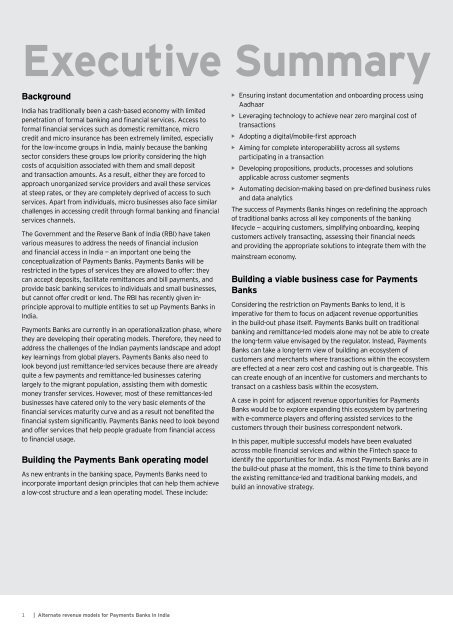Alternate revenue models for Payments Banks in India
29oMCDq
29oMCDq
Create successful ePaper yourself
Turn your PDF publications into a flip-book with our unique Google optimized e-Paper software.
Executive Summary<br />
Background<br />
<strong>India</strong> has traditionally been a cash-based economy with limited<br />
penetration of <strong>for</strong>mal bank<strong>in</strong>g and f<strong>in</strong>ancial services. Access to<br />
<strong>for</strong>mal f<strong>in</strong>ancial services such as domestic remittance, micro<br />
credit and micro <strong>in</strong>surance has been extremely limited, especially<br />
<strong>for</strong> the low-<strong>in</strong>come groups <strong>in</strong> <strong>India</strong>, ma<strong>in</strong>ly because the bank<strong>in</strong>g<br />
sector considers these groups low priority consider<strong>in</strong>g the high<br />
costs of acquisition associated with them and small deposit<br />
and transaction amounts. As a result, either they are <strong>for</strong>ced to<br />
approach unorganized service providers and avail these services<br />
at steep rates, or they are completely deprived of access to such<br />
services. Apart from <strong>in</strong>dividuals, micro bus<strong>in</strong>esses also face similar<br />
challenges <strong>in</strong> access<strong>in</strong>g credit through <strong>for</strong>mal bank<strong>in</strong>g and f<strong>in</strong>ancial<br />
services channels.<br />
The Government and the Reserve Bank of <strong>India</strong> (RBI) have taken<br />
various measures to address the needs of f<strong>in</strong>ancial <strong>in</strong>clusion<br />
and f<strong>in</strong>ancial access <strong>in</strong> <strong>India</strong> — an important one be<strong>in</strong>g the<br />
conceptualization of <strong>Payments</strong> <strong>Banks</strong>. <strong>Payments</strong> <strong>Banks</strong> will be<br />
restricted <strong>in</strong> the types of services they are allowed to offer: they<br />
can accept deposits, facilitate remittances and bill payments, and<br />
provide basic bank<strong>in</strong>g services to <strong>in</strong>dividuals and small bus<strong>in</strong>esses,<br />
but cannot offer credit or lend. The RBI has recently given <strong>in</strong>pr<strong>in</strong>ciple<br />
approval to multiple entities to set up <strong>Payments</strong> <strong>Banks</strong> <strong>in</strong><br />
<strong>India</strong>.<br />
<strong>Payments</strong> <strong>Banks</strong> are currently <strong>in</strong> an operationalization phase, where<br />
they are develop<strong>in</strong>g their operat<strong>in</strong>g <strong>models</strong>. There<strong>for</strong>e, they need to<br />
address the challenges of the <strong>India</strong>n payments landscape and adopt<br />
key learn<strong>in</strong>gs from global players. <strong>Payments</strong> <strong>Banks</strong> also need to<br />
look beyond just remittance-led services because there are already<br />
quite a few payments and remittance-led bus<strong>in</strong>esses cater<strong>in</strong>g<br />
largely to the migrant population, assist<strong>in</strong>g them with domestic<br />
money transfer services. However, most of these remittances-led<br />
bus<strong>in</strong>esses have catered only to the very basic elements of the<br />
f<strong>in</strong>ancial services maturity curve and as a result not benefited the<br />
f<strong>in</strong>ancial system significantly. <strong>Payments</strong> <strong>Banks</strong> need to look beyond<br />
and offer services that help people graduate from f<strong>in</strong>ancial access<br />
to f<strong>in</strong>ancial usage.<br />
Build<strong>in</strong>g the <strong>Payments</strong> Bank operat<strong>in</strong>g model<br />
As new entrants <strong>in</strong> the bank<strong>in</strong>g space, <strong>Payments</strong> <strong>Banks</strong> need to<br />
<strong>in</strong>corporate important design pr<strong>in</strong>ciples that can help them achieve<br />
a low-cost structure and a lean operat<strong>in</strong>g model. These <strong>in</strong>clude:<br />
••<br />
Ensur<strong>in</strong>g <strong>in</strong>stant documentation and onboard<strong>in</strong>g process us<strong>in</strong>g<br />
Aadhaar<br />
••<br />
Leverag<strong>in</strong>g technology to achieve near zero marg<strong>in</strong>al cost of<br />
transactions<br />
••<br />
Adopt<strong>in</strong>g a digital/mobile-first approach<br />
••<br />
Aim<strong>in</strong>g <strong>for</strong> complete <strong>in</strong>teroperability across all systems<br />
participat<strong>in</strong>g <strong>in</strong> a transaction<br />
••<br />
Develop<strong>in</strong>g propositions, products, processes and solutions<br />
applicable across customer segments<br />
••<br />
Automat<strong>in</strong>g decision-mak<strong>in</strong>g based on pre-def<strong>in</strong>ed bus<strong>in</strong>ess rules<br />
and data analytics<br />
The success of <strong>Payments</strong> <strong>Banks</strong> h<strong>in</strong>ges on redef<strong>in</strong><strong>in</strong>g the approach<br />
of traditional banks across all key components of the bank<strong>in</strong>g<br />
lifecycle — acquir<strong>in</strong>g customers, simplify<strong>in</strong>g onboard<strong>in</strong>g, keep<strong>in</strong>g<br />
customers actively transact<strong>in</strong>g, assess<strong>in</strong>g their f<strong>in</strong>ancial needs<br />
and provid<strong>in</strong>g the appropriate solutions to <strong>in</strong>tegrate them with the<br />
ma<strong>in</strong>stream economy.<br />
Build<strong>in</strong>g a viable bus<strong>in</strong>ess case <strong>for</strong> <strong>Payments</strong><br />
<strong>Banks</strong><br />
Consider<strong>in</strong>g the restriction on <strong>Payments</strong> <strong>Banks</strong> to lend, it is<br />
imperative <strong>for</strong> them to focus on adjacent <strong>revenue</strong> opportunities<br />
<strong>in</strong> the build-out phase itself. <strong>Payments</strong> <strong>Banks</strong> built on traditional<br />
bank<strong>in</strong>g and remittance-led <strong>models</strong> alone may not be able to create<br />
the long-term value envisaged by the regulator. Instead, <strong>Payments</strong><br />
<strong>Banks</strong> can take a long-term view of build<strong>in</strong>g an ecosystem of<br />
customers and merchants where transactions with<strong>in</strong> the ecosystem<br />
are effected at a near zero cost and cash<strong>in</strong>g out is chargeable. This<br />
can create enough of an <strong>in</strong>centive <strong>for</strong> customers and merchants to<br />
transact on a cashless basis with<strong>in</strong> the ecosystem.<br />
A case <strong>in</strong> po<strong>in</strong>t <strong>for</strong> adjacent <strong>revenue</strong> opportunities <strong>for</strong> <strong>Payments</strong><br />
<strong>Banks</strong> would be to explore expand<strong>in</strong>g this ecosystem by partner<strong>in</strong>g<br />
with e-commerce players and offer<strong>in</strong>g assisted services to the<br />
customers through their bus<strong>in</strong>ess correspondent network.<br />
In this paper, multiple successful <strong>models</strong> have been evaluated<br />
across mobile f<strong>in</strong>ancial services and with<strong>in</strong> the F<strong>in</strong>tech space to<br />
identify the opportunities <strong>for</strong> <strong>India</strong>. As most <strong>Payments</strong> <strong>Banks</strong> are <strong>in</strong><br />
the build-out phase at the moment, this is the time to th<strong>in</strong>k beyond<br />
the exist<strong>in</strong>g remittance-led and traditional bank<strong>in</strong>g <strong>models</strong>, and<br />
build an <strong>in</strong>novative strategy.<br />
1 | <strong>Alternate</strong> <strong>revenue</strong> <strong>models</strong> <strong>for</strong> <strong>Payments</strong> <strong>Banks</strong> <strong>in</strong> <strong>India</strong>


